USB to I2C Converter with Virtual COM Port FT230XS
Highlights
- USB to I2C Converter
- Hardware Master I2C Communications to I2C Nodes
- Mounts as a COM Port and Powered by the USB Port
- Compatible with All NCD I2C Devices
- FT230XS USB to Serial Converter
- Supports I2C Read, Write, Write Read Commands
- I2C Bus Scan Command Reports All Start Addresses
- Supports Device Reboot Commands and Manual I2C Stop
- Free Windows AnyI2C and Alpha Station Software
- Including Visual Studio Libraries for Easy Use
- Visual Studio Control Panels for Many I2C Devices
- Hardware Compatible with Linux and Mac (No Software)
- USB Micro Interface to 4-Pin nodeLynk I2C Port
- 115.2K Baud Default Baud Rate, 230.4K Max Baud
- I2C Bus Speed of 38, 100, 200, 300, and 400KHz
USB to I2C conversion should be easy, powerful, and fast! Convert USB to I2C using over a virtual COM port with two simple commands for writing and reading I2C data. Connect NCD I2C devices with a desktop computer using this tiny I2C adapter and take control using our software or pick apart the source code and write your own software in any language that supports the FTDI FT32XS virtual COM port driver (which is just about all computers and languages). Plug in our USB to I2C converter into any available USB port on your PC and it mounts as a COM port, start sending commands at 115.2K Baud. Use our FREE AnyI2C software and start talking to the complete ecosystem of NCD I2C Devices with just a few button clicks. Watch data communications in the Log window so you can see it work.
Use this USB interface to read sensors, control relays and PWM controllers. Use in industrial 4-20 mA read/write applications, and much more. Read light sensors, temperature/humidity sensors, potentiometers, moisture sensors, all at a very low cost. This converter is hardware compatible with all programming languages and operating systems that support the FT230XS. Drivers are available from FTDIChip.com.
Includes USB Type A to USB Micro Cable.
The Best USB to I2C Converter Available!
This USB to I2C converter is now one of our most popular products with TONS of repeat customers! We’ve seen all the USB to I2C converters from other companies, some charging a fortune and require specialized drivers that are hard to implement. Some converters don’t even work without tons of software setup. This converter is ready to go to work immediately! Plug it in and it’s ready to start talking to I2C devices, no complex configuration, and no bizarre drivers.
NEW VERSION 6 Now Shipping:
Orders Shipping 8/2/2019 and Later now include Version 6, which is nearly our final release version of firmware for this device. Version 6 includes many improvements over version 5. Like Version 5, this device is configured using Alpha Station 1.0.0.5 or later. Alpha Station 1.0.0.6 or later is required to take full advantage of device settings. The following features were added to Version 6 Firmware.
- Now Supports I2C Bus Scan
- Now Supports I2C Bus Speed Selection Stored in EEPROM
- Now Supports Bootup of I2C Bus Speed of 38, 100, 200, 300, and 400 KHz
- Added a I2C Write + Read Command for Faster Communications with a Single Transaction
- Added a Soft Reboot Command
- Added a Hard Reboot Command
- Added a Manual I2C Stop Command
- Removed Support for Base Station Software (Not Enough Room in CPU)
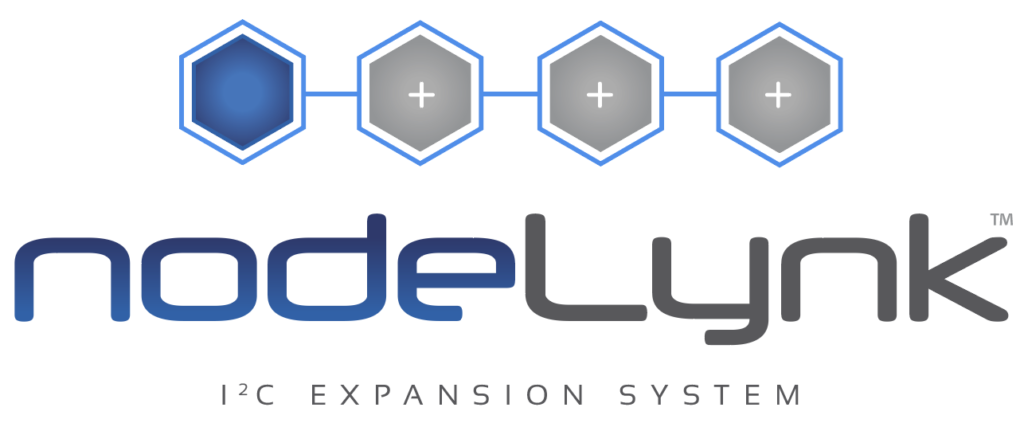
nodeLynk™ Master Adapter
This is a nodeLynk Master adapter. nodeLynk Master adapters speak to a chain of nodeLynk devices using I2C communications.
What is nodeLynk?
Chain expansion devices using nodeLynk. Connect a wide variety of accessories to expand the capabilities of a nodeLynk compatible controller. Use nodeLynk to add Relay Controllers, Sensors, PWM Drivers, Displays, and a wide variety of 4-20mA, 0-10V ADCs and DACs, as well as a wide array of TTL & Isolated GPIO devices. All nodeLynk devices use I2C communications to chain devices together. nodeLynk is an easy way to expand functionality without soldering. nodeLynk allows expansion in seconds so you can focus on your software and firmware development.

Designed with Visual Studio in Mind
The NCD USB to I2C Converter is a perfect companion to add automation, sensing, monitoring, and control features to Visual Studio applications. We are always improving our Alpha Station Software framework, which includes all libraries needed to communicate to every kind of I2C sensor and controller imaginable. Simple libraries for I2C Read, Write, and Write Read operations make it easy to talk to all kinds of hardware with minimal time investment. Talk to displays, sensors, multiplexers, relay controllers, pulse width modulators, and more. The Alpha Station framework is ready to go to work monitoring and controlling using Visual Studio Community Edition (free from Microsoft.com).
Control LCD Displays with Visual Studio
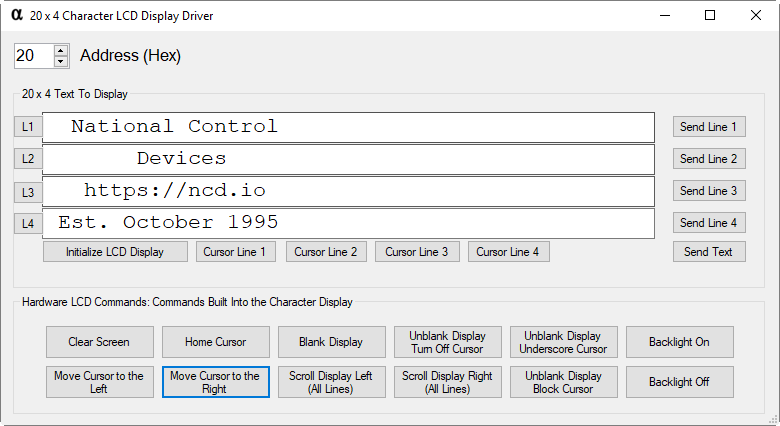

Alpha Station provides you with a working sample framework, take a look at the source code to see how easy it is to control this display:

Read MAX1069 Analog to Digital Converters with Visual Studio
Alpha Station gives you the tools you need to quickly read and display Analog to Digital Values such as the MAX1069 connected to a 8-Channel Multiplexer to display the result. Reading and Displaying ADC Values could not get any easier. Notice how we use the I2C Write Read Command to talk to the MAX1069 with a start address of &H37, this command handles all the low-level I2C communications to the chip, you simply specify the start address, number of bytes you would like to read (2), and the delay (0) between the Write and Read operation. When the chip returns a response, it should be 2 bytes in Length. The response is then converted to a 14-Bit value using the NCDLib.Math.MSLBLS14 command. The value can then be displayed directly to the console.
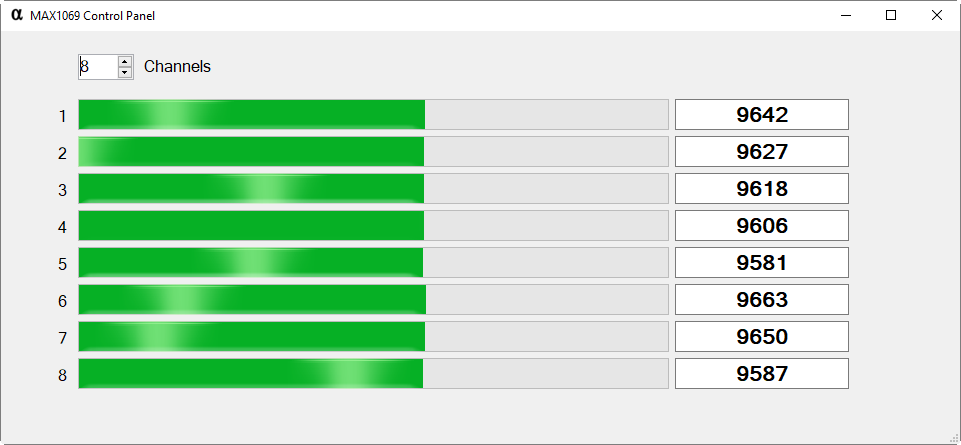
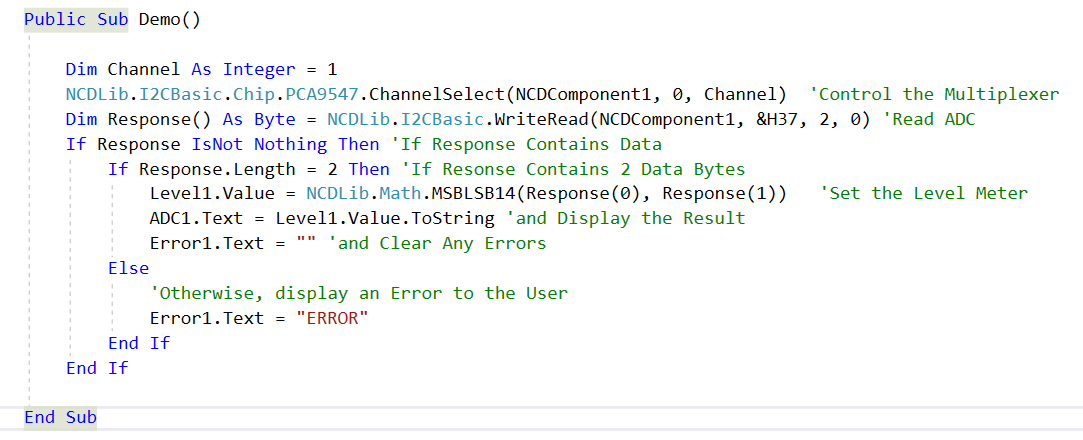
Control a AS1115 LED Display with Visual Studio
Alpha Station Libraries make it easy to control hardware. The AS1115 Library is used to communicate numeric values directly to a LED display. Values from 0 to 999 are supported as well as brightness levels of 0 to 15. Simple library calls are all it takes to setup a dedicated hardware numeric display.
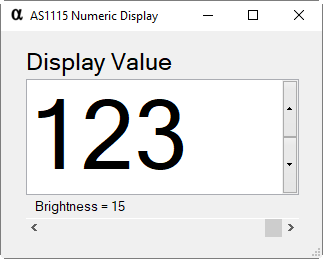
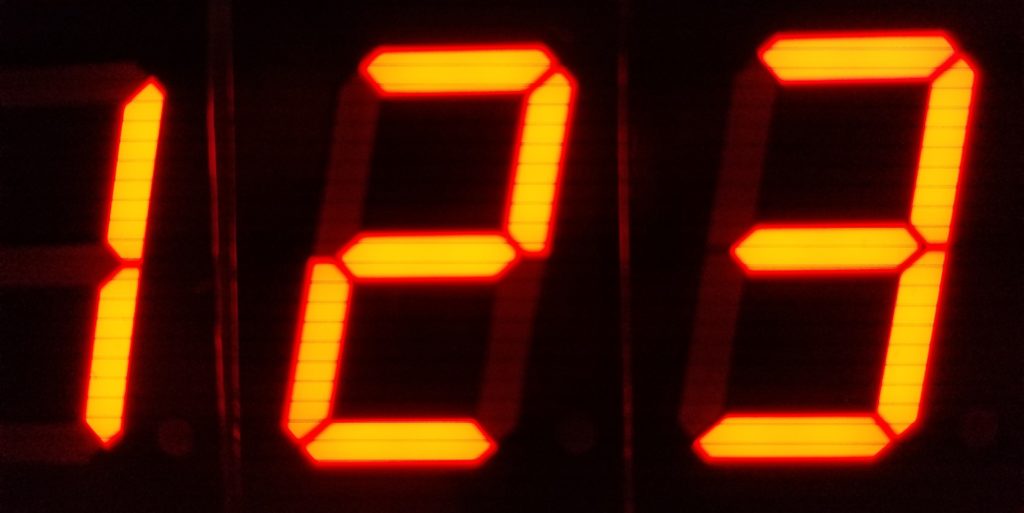
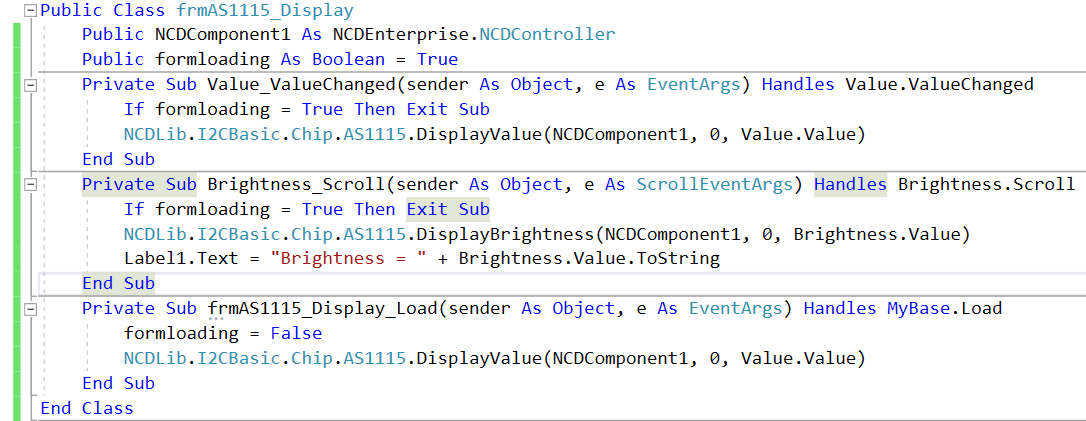
Version History
VERSION 5 CHANGES:
Orders Shipping 7/31/2019 through 8/1/2019 and Later Include Updated firmware to Make the Stop Command in Version 4 Optional. As the CPU is currently very full, code has been optimized in this version to reduce memory usage, Clearing the way for a Version 6.
To Use Version 4 Changes, Please Download Base Station at https://ncd.io/start and click on “I2C Converter Device Configuration” and Un-check the “Reserved” Check Box, and be Sure to “Save Settings”. Later Versions of Base Station will Indicate this option as “Smart I2C Stop”.
This change was Necessary as Version 4 Prevented Proper Operation of I2C Bus Scan Features in AnyI2C Software.
VERSION 4 CHANGES:
Orders Shipping 6/27/2019 through 7/30/2019 Include Updated firmware to Issue a Stop Command Regardless of Error or No-Error on the I2C Bus. This version also includes all Version 3 Changes.
VERSION 3 CHANGES:
Orders shipping 5/7/2018 through 6/26/2019 now include an updated version of firmware that increases compatibility, is 3x faster, and adds new simplified I2C communication commands. Documentation for this update is currently being prepared.
Version 3 Changes:
- Added Simplified I2C Write Command
- Added Simplified I2C Read Command
- I2C Communications is Now Hardware Based, Not Software Based
- I2C Communications Speed has Improved from 38KHz to 100KHz
- Software Programmable Communication Speeds:
- 38KHz, 100KHz, 200KHz, 300KHz, and 400KHz
- Programmable Baud Rates Supported:
- 9600, 19.2K, 38.4K, 57.6K, 115.2K. 230.4K
Mechanical Drawing

Wiring Diagrams
Essential
- Serial to I2C Conversion
- AnyI2C I2C Communications Quick Start Guide
- API Codec Quick Start Guide
- I2C Communications Quick Start Guide
Tutorials
Datasheets
Community Repositories


